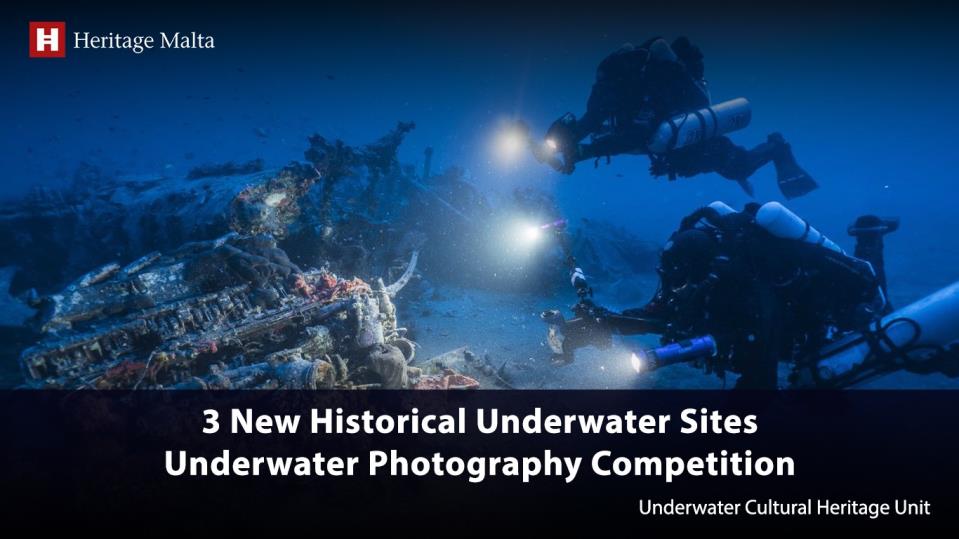The Underwater Cultural Heritage Unit within Heritage Malta has announced the addition of three new historical underwater sites for divers from across the globe to explore. Heritage Malta has also released an underwater photography competition to promote Malta’s patrimony.
With the addition of these three sites, the unit now has 15 underwater sites in total under its wing as it continues working on opening other sites for 2021 and 2022.
The sites include a B24 Liberarator located off the coast of Marsaxlokk harbour which is an American heavy bomber which throughout the Second World War saw extensive use in all branches of the American Armed Forces and even some of the Allied forces. It is believed that this aircraft found itself at the seabed after failed landing attempts, due to engine trouble, at Luqa during the 6th May 1943 bombings which forced the 10-member crew to ditch the plane in the sea.

The second in the list is Douglas A-1 Skyraider located off the shore of Birżebbuġia. This is an American single-seat attack aircraft that was in service between the late 1940s and early 1980s, boasting a remarkably long and successful career in the United States (US) Navy, Marine Corps and Air Force, with some service also in the British Royal Navy and French Air Force, amongst others.
An aircraft wreck site located off the southern coast of Birżebbuġia, can be identified as the Douglas A-1 Skyraider, serial code 09236 that was piloted by Lt Robert HL Reeb. This Skyraider was one of four aircraft tasked with mail duties between the Ħal Far airfield and the aircraft carrier USS Midway. The aircraft carrier was commissioned a week after the end of the Second World War, and was the largest ship in the world until 1955. In October 1947, the USS Midway was on her first annual deployment with the 6th Fleet in the Mediterranean.
In December 1947, Lt Reeb’s Skyraider suffered a total engine failure, only minutes after taking off from Ħal Far, and attempts at restarting the engine were not successful.
Last but not least, there is the Junkers Ju88, the second of its kind within the Underwater Cultural Heritage Unit, located North West off the coat of Marsascala. The Junkers Ju88 is considered to be one of the most versatile combat aircraft of the Second World War, and was operated by the German Luftwaffe throughout the conflict and across all fronts.
Archaeology professor and chairperson for the Underwater Cultural Heritage Unit Timmy Gambin said that these sites will be making great investment in the diving industry for people who come from abroad looking to visit these sites.
“We received a lot of cancellations due to the pandemic; however, we are already seeing a rise in interest in these sites.”
He explained that these sites a result of a joint effort between the unit, the armed forces of Malta, Transport Malta, the University of Malta and the Superintendence of Cultural Heritage which together train individuals and invest in equipment for the surveillance of such sites.
He added that the unit has launched a photography competition for underwater sites, not only ones under the remit of Heritage Malta but even other sites which are open without any fees. The competition has two criteria to be included in the pictures; the view of the site and the interaction between natural and historical elements.

Heritage Malta CEO Noel Zammit said that the authority gives equal important to both land and underwater patrimony as these sites tell the story of our country while attracting more tourism and place Malta and Gozo on the global map.
Heritge Malta Executive Director Mario Cutajar explained that the authority is is going through an interesting time as it is no longer the same entity of 2003.
“This is the main entity that takes care of Malta’s patrimony, by researching on it, preserving it and making it accessible to the public. Through research we can find what the impact it has on Malta it while accessibility promotes national identity which is important in making Malta distinguishable from other countries.”
Culture Minister José Herrera said that the Ministry is looking into registering such underwater sites under the United Nations Educational, Scientific and Cultural Organisation (UNESCO) just like the numerous sites found on land which are already registered. This is not only important form a preservation perspective but also a branding one.